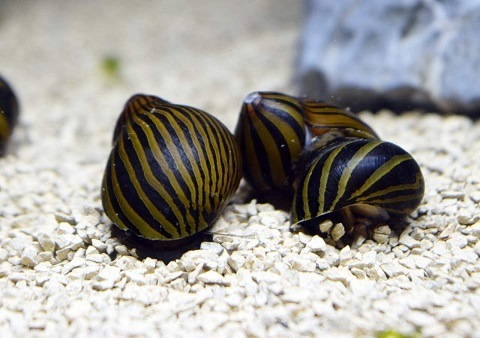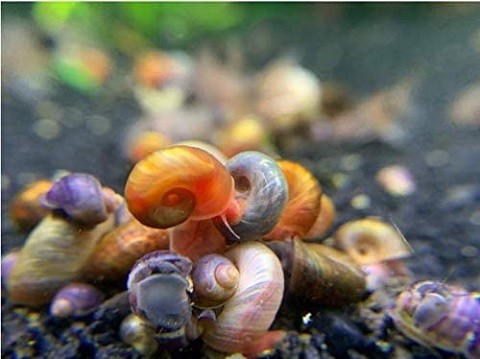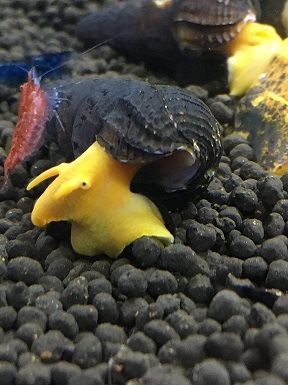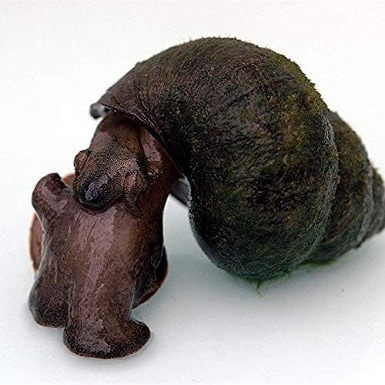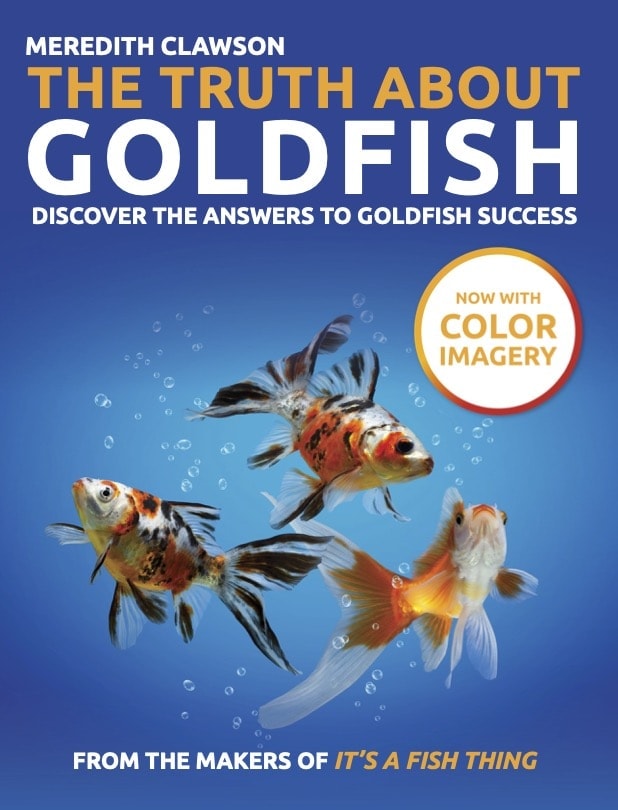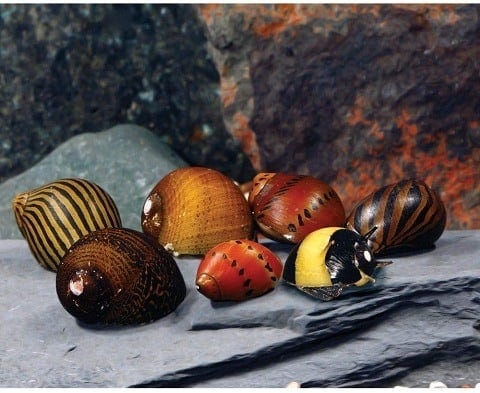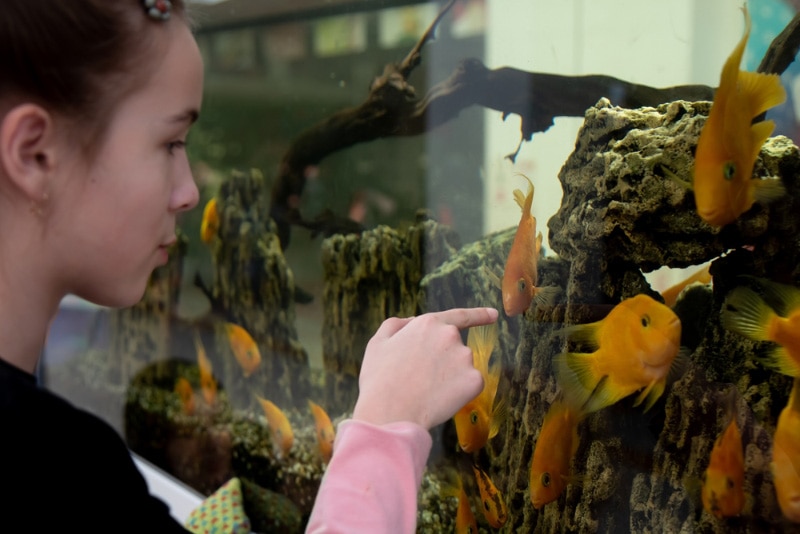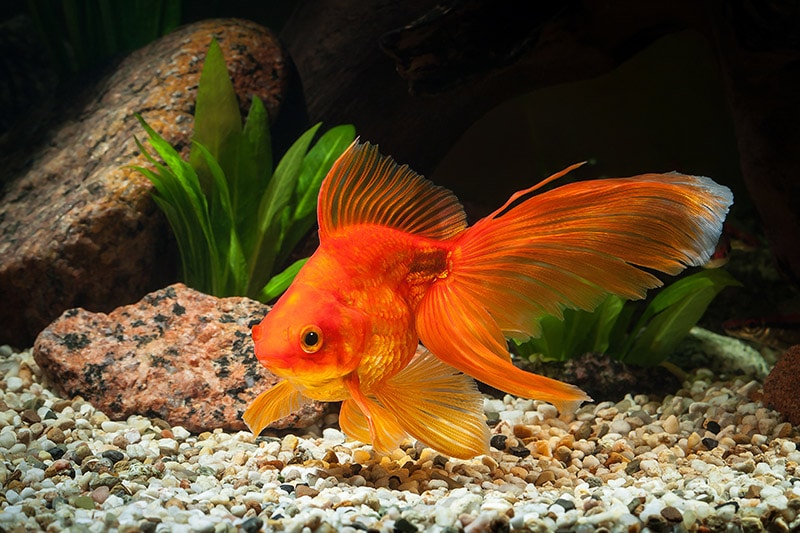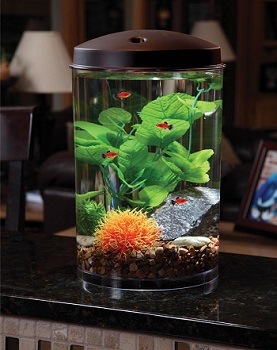5 Best Algae Eaters for Goldfish Tanks in 2024: Reviews & Top Picks

Updated on
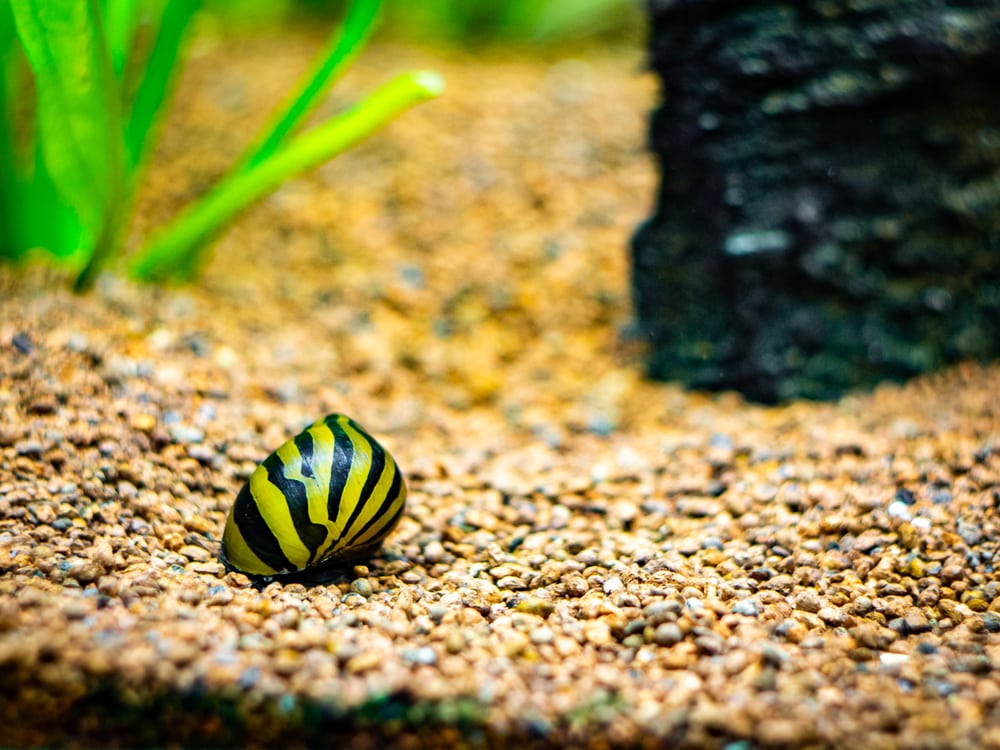
One of the most dreaded things to happen to most goldfish aquariums is the overrun of unwanted algae. Whether green, black, red, or brown algae, it can cause your beautifully aqua-scaped goldfish tank to slowly become ridden with this plant-like protist. A set of panic can set in from being unable to see your goldfish clearly. So, at a loss of what to do, we hope this article can give you some encouragement and guidance on helpful algae eaters that can comfortably live with your goldfish.
When we think of algae eaters, we commonly think of plecos or catfish, who cannot comfortably live with goldfish due to the biowaste production and temperature requirements. What we do not think of is the cute little shelled creatures crawling around the tank.
Snails are by far one of the most positively reviewed algae eaters available on the market. Commonly known as a pest in the aquarium industry, these little creatures are not all too bad. We have compiled a list of our top five algae eaters who have received the most positive reviews!
A Quick Comparison of Our Favorites of 2024
| Rating | Image | Product | Details | |
|---|---|---|---|---|
| Best Overall |

|
SevenSeaSupply Zebra Nerite Aquarium Snails |
|
Check Price |
| Best Value |

|
Kazen Aquatic Ramshorn Snails |
|
Check Price |
| Premium Choice |

|
Awesome Aquatics Poso Sulawesi Rabbit Snails |
|
Check Price |

|
Toledo Goldfish Live Trapdoor Snails |
|
Check Price | |

|
WorldwideTropicals Live Nerite Snails |
|
Check Price |
The 5 Best Algae Eaters for Goldfish Tanks
1. SevenSeaSupply Zebra Nerite Aquarium Snails – Best Overall
Hands-down one of the most recommended algae eaters is the zebra nerite snail. Aside from their appealing look with black and whitish-yellow stripes as the name suggests, the nerite snail readily devourers all types of algae growing on your goldfish’s tanks. A common worry among aquatic snail owners is that they are well known for their ability to rapidly reproduce and quickly overrun your aquarium, hence their label as tank pests. For the zebra nerite snail, they can only reproduce sexually, unlike most aquarium snails who can reproduce asexually. Nerite snail eggs can only successfully hatch in brackish water, and not your goldfishes preferred pure freshwater conditions.
Nerites of an adult size get along well with goldfish and cohabit peacefully in the tank. Nerites are on the smaller side of aquarium snails. SevenSeaSupply includes a group of five snails when you make a purchase and have a guaranteed live arrival with a 100% guarantee policy. If you open your package to some dead or poorly snails, they will happily refund or replace them with image or video proof. The group of five ensures your algae-ridden goldfish tank will have enough mouths to consume the algae faster than it has a chance to grow.
- Does not produce well in pure freshwater tanks
- Adult size remains untouched by goldfish
- Sold as a pack of 5 zebra nerite snails
- Shell stops them from reaching algae in narrow spaces
- Young nerites may be eaten by larger goldfish
2. Kazen Aquatic Ramshorn Snails – Best Value
A colorful addition to your goldfish’s tank, the ramshorn snails from Kazen Aquatics. Known as the gems among aquatic snail keepers, ramshorn snails consume algae at a rapid pace. Arriving in a multi-colored group of 10 or more, Kazen Aquatics ensures 100% live healthy ramshorn snails upon arrival with a refund or replacement guarantee. This makes it the best algae eater for money this year.
The colors produced are enticing, from blues to purples. The juveniles will not fit in a larger goldfish’s mouth and peacefully live amongst one another. Ramshorns rapidly reproduce in good conditions, although this is undesirable to some. Goldfish tank owners with constant algae growth may welcome the breeding. However, breeding may be kept in check by your goldfish, who will happily eat the eggs and young if they remain in the tank.
The ramshorn’s shell does not have the same stand-out spiral as other snails; instead, it has a flattened side profile with spiralling grooves turning towards the middle. They are excellent at keeping algae growth in control and can even reach narrower spaces due to their flattened shell growth.
- Readily consumes algae
- 100% live and healthy arrival guarantee
- Comes in a variety of colors
- Rapidly reproduces in freshwater tanks
- Young ramshorns can be eaten by larger goldfish
3. Awesome Aquatics Poso Sulawesi Rabbit Snails – Premium Choice
The instantly recognizable Poso Sulawesi rabbit snail is an amazing algae eater, rare among aquarium keepers but prized for its delightful orange body coloration. They are one of the larger growing aquatic snails available and will consume a greater deal of algae in a shorter period than their smaller counterparts.
Polo Sulawesi rabbit snails have an interestingly long snout, almost resembling an elephant. Growing to an average size of 3 to 4 inches long, these aquatic snails as both juveniles and adults are too large to fit in goldfish’s mouths. These snails are peaceful and do not seemingly entice goldfish, this lets them munch away at their primary diet, algae.
Consuming nearly all types and colors of algae, even showing an interest in black beard algae, which some snails do not touch. Awesome aquatics sends out a package of five Poso Sulawesi rabbit juvenile snails per shipment, with a guarantee they can handle and survive in a wide range of water conditions and longer shipment than other aquatic snails. A bonus is that these snails reproduce relatively slow and steadily, so you will not have an over-bearing number of snails taking over your goldfish’s tank.
- Reproduces slowly
- Too large to fit in goldfish’s mouths
- Hardy
- Produce more waste than smaller snails
- Shipment is pricier
4. Toledo Goldfish Live Trapdoor Snails
The hardy trapdoor snail is well known for thriving in a variety of tank and pond conditions, making them an excellent outdoor goldfish pond cohabitor. Peaceful in nature and a moderately fast algae eater, you will find your unwanted algae growth diminishing in just a few weeks. The tranquil snails display a cone-shaped spiralling shell. Although they are not the most attractive snail out there, they add a natural-looking addition to goldfish vegetation-based ponds or tanks.
When startled, these snails quickly zip into their shell, avoiding the prying mouth of a hungry goldfish. They grow to about 2 inches, with the females being larger than males. They can easily acclimate into a variety of goldfish homes, from indoor or outdoor ponds to your small fancy goldfish tanks. Toledo goldfish ensures a healthy arrival of five trapdoor snails with fast shipping. They may take a while to come out of their shell after arrival, but once they do, they will be quick at diminishing that algae!
- Hardy
- Peaceful
- Adapt easily
- Reproduce quickly
- Not very appealing in tanks due to their coloration
- Relatively shy
If you're new to the world of goldfish or are an experienced goldfish keeper that loves to learn more, we recommend you check out our best-selling book, The Truth About Goldfish, on Amazon. From diagnosing illnesses and providing correct treatments to ensuring your goldies are happy with their setup and your maintenance, this book brings our blog to life in color and will help you to be the best goldfishkeeper you can be.
5. WorldwideTropicals Live Nerite Snails
A fast algae eater, the nerite snails from Worldwide Tropicals is easily able to adapt to your well-maintained goldfish’s freshwater tank. Although they are on the smaller side and at risk of being eaten or injured by larger goldfish, they do an amazing job at keeping algae at bay. In the packaging you will receive a mix of six nerite snails in total, all varying in coloring and type. With nerites only being able to reproduce successfully in brackish waters, you will be able to keep the numbers low, ideal if you have a smaller tank or do not want an overrun goldfish tank.
The suppliers advise keeping an eye on water parameters for these snails, as they are susceptible to high levels of ammonia, nitrite, and nitrates in your goldfish tank. Due to goldfish’s large bio-load, these parameter spikes are common, so it is best to stick to regular water testing while keeping these algae eaters. Worldwide Tropicals ensures fast shipping with an email and tracking number, so be sure to have your nerite snails at your door in no time.
- Fast shipping
- Variety mix
- Can only reproduce successfully in brackish waters
- Susceptible to poor water conditions
- Young nerites can easily fit into goldfish’s mouths
- Regular water testing is required to maintain the snail’s health
Buyer’s Guide: Selecting The Best Algae Eater for Goldfish Tanks
Factors to Consider
- Tank size: If you own a goldfish tank on the smaller side, it may be harder to house a number of the larger growing snails over 1.5 inches. This is because their potential growth and overall size can make a small goldfish tank looked cramped and overbearing. A tank of 10 gallons or more can house a small number of aquarium snails and your goldfish comfortably.
- Goldfishes size: If you keep large growing goldfish such as the common or comets, you may find your goldfish will eat, or at least attempt to eat your smaller growing snails. This can be avoided by purchasing snails larger than your goldfish’s mouth.
- Algae growth rate: If you find your algae problem is not too rapid, you will be able to maintain the growth with a set of smaller growing snails in a small group than if you were to have rapidly growing algae which large growing snails in medium groups can quickly take care of.
- Filtration: Larger growing snails or snails that consume algae at a fast rate, will produce a higher bio-load. They will therefore require an adequate filtration system to remove waste efficiently alongside your goldfish’s already high waste production.
- Live plants: Some snails may find a liking to a specific plant in your goldfish’s tank, if your goldfish has not got to it already, your snail might! Be sure to keep snails who do not find a particular interest in the plants you keep.
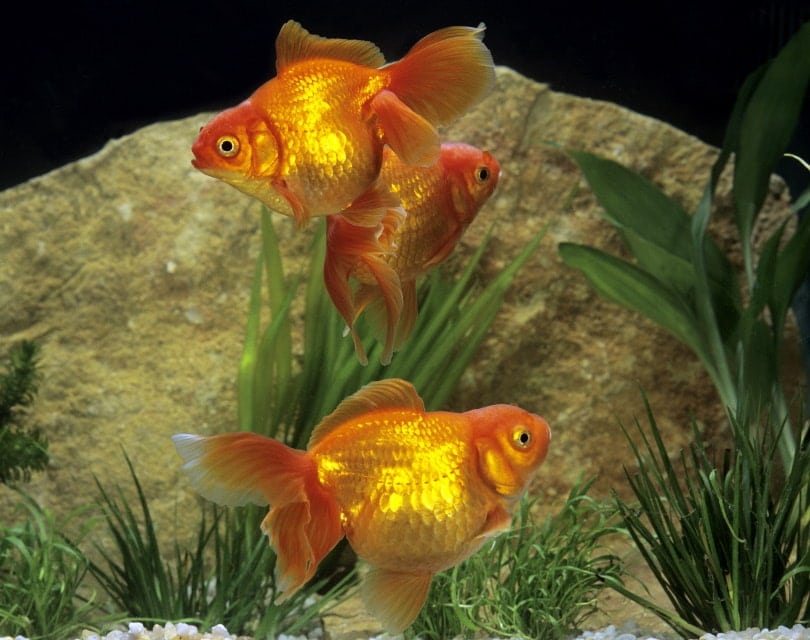
What Makes a Good Algae Eater?
The SevenSeaSupply zebra nerite aquarium snails make an excellent algae eater. Readily available and appealing colorations, we recommend them for stubborn and rapid algae growth. The pros outweigh the cons, and they are not classified as pests in goldfish tanks, due to their ability to only reproduce in brackish water conditions.
- Health: Choose snails that have received positive reviews upon arrival, avoid purchasing from suppliers that get a lot of poor snail’s health complaints.
- Coloration: Choose snails that come in colors that attract you and will not make your goldfish tank look dull or too over-bearing.
- Bio-load: Snails that produce a smaller bio-load will be able to be housed in tanks with low filtration, without greatly affecting the water parameters.
- Small and large: Aquatic snails come in many different sizes, the best algae eater snails range from 1 to 4.5 inches at maximum growth potential.
- Fast to slow reproducing rates: Most algae-eating snails rapidly reproduce in freshwater tanks, leading to a quick rise in your aquatic snail population, with nerites being an exception and reproduce in saltier water than goldfishes require.
- Consume a larger portion of algae: Larger growing algae-eating snails will be able to consume algae at a much more rapid rate than smaller growing snails, due to the size of their mouth.
What Type of Snails Do You Need?
If your goldfish’s tank is becoming increasingly covered in algae no matter what your try, you may require larger snails that reproduce at a steady rate to produce enough snails to take care of your algae problem. If you have an occasional outbreak of fast algae growth, smaller snails such as nerites will suffice to maintain the algae growth.
Types of Algae-eating Snails
You mainly get two primary types of algae-eating snails, ones that can comfortably live-in brackish water that has higher salt content in the water, or those from pure freshwater that has little to no salts in the water.
The Cost Factor
Depending on how fast you want your snail shipping to take place, as well as the rarity and reproducing rate of the snails, you may find some to be more expensive than others. Although they are reasonably priced, and you are paying for the quality and benefits of keeping this type of snail. A larger number of snails of a mixed variety in coloration with be on the pricier end than common, dull-colored snails in small groups.
| Small growing snails under 1.5 inches | Large growing snails over 1.5 inches |
| Reproduce quickly | Reproduce slowly |
| Young and some juveniles can fit in goldfish’s mouth | Consume more algae in a short duration of time due to their larger mouths |
| Can live in a smaller tank | Need a larger tank to support their size potential |
| Smaller bio-load | Larger bio-load |
Conclusion
We hope to have helped you make an informed decision on what snails are right for your goldfish’s tank’s algae problems. Out of our top five algae eater reviews, we highly recommend the Poso Sulawesi rabbit snails (our premium choice.) These snails seem to offer the most benefits for their duty as an algae eater in your goldfish tank as well as reproducing at a slow and steady rate.
Being able to grow to the potential size of 4 inches, the Polo Sulawesi snail is excellent for goldfish tanks and maintaining your algae growth problems, as their large size makes them unable to fit in your goldfish’s mouth. Being the best value for money, we agree they are worth every cent at controlling algae problems in your goldfish tank without causing an over-population of these snails.
Featured Photo Credit: Joan Juarez, Shutterstock




